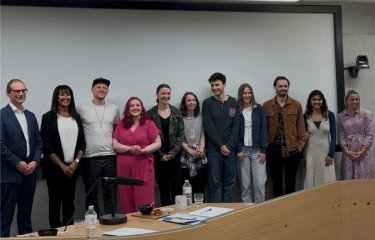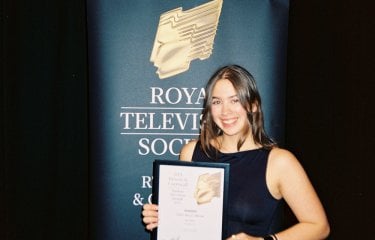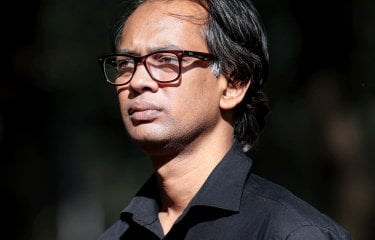Falmouth lecturer’s new play, 'A Child of Science', receives glowing reviews at Bristol Old Vic
09 July 2024

We caught up with Acting BA lecturer Gareth Farr to discuss his play about the creation of IVF, A Child of Science, after its premiere. Directed by Matthew Dunster, the production features Tom Felton (Harry Potter), Jamie Glover (Waterloo Road, Casualty), Meg Bellamy (The Crown), Adelle Leonce (Fool Me Once, Black Mirror), and Sonoya Mizuno (House of the Dragon).
Gareth, who’s already received a Bruntwood prize for playwriting on Britannia Waves The Rules, brought his new play to Bristol Old Vic on 5 June.
The piece delves into one of the most significant medical breakthroughs of the 20th century: the creation of human life in vitro. It shines a light on the efforts of Patrick Steptoe, Robert Edwards, and Jean Purdy, whose work led to the birth of the world's first IVF baby in 1978. Despite facing considerable hostility, their perseverance gave hope to millions of people struggling with infertility.
★ ★ ★ ★ ★ "An era-defining play, rich in social scope and emotional depth"
StageTalk Magazine
★ ★ ★ ★ ★ "Felton’s presence is magnetic"
Entertainment Now
★ ★ ★ ★ ★ "Brilliantly written... Imaginatively and slickly staged... Wonderfully acted"
West End Best Friend
★ ★ ★ ★ ★ "The story [has] real heart"
Bristol Post
★ ★ ★ ★ "Powerfully poignant"
The Daily Mail
★ ★ ★ ★ "Powerful... slick and emotive"
WhatsOnStage
★ ★ ★ ★ "A glowing tribute to all those involved in the development of IVF"
Morning Star
★ ★ ★ ★ "A must-watch"
Lifestyle District
__
Earlier this year, we had the privilege of speaking with Gareth Farr about his play ahead of its debut. Now, as 'A Child of Science' receives outstanding reviews and captures audiences and critics alike, we met with Gareth to reflect on its progress.
A Child of Science has had an incredible start with outstanding reviews. What has been the most surprising or gratifying piece of feedback you've received so far? Can you share any particularly memorable moments from the rehearsal process or the initial performances?
There have been so many surprising moments throughout the whole process. I am still having them. It all starts with me sitting on my own with a blank page and an idea. I can remember that moment so clearly, not knowing if anything would be usable and hoping that the years of work ahead of me would one day result in a performance. There has been so much research, conversation, imagination, and most importantly, collaboration that has gone into making A Child of Science. I could never have imagined how much work would be needed and how many people would contribute to the story, many of whom have their own connection to fertility treatment and a vested, personal interest in making the play something special.
Perhaps the most significant conversation was with Grace MacDonald, one of the 282 women who volunteered to be part of the initial IVF trials. The play celebrates the contribution of these women, and talking to Grace was extremely important.
How has Matthew Dunster’s direction influenced the final presentation of A Child of Science?
I have known Matthew for a long time; we worked together as actors but have been close friends for around twenty years. He has IVF triplets, and both Matthew and his wife Mee-Ling were a vital support to us as we went through our four cycles of IVF. I first approached Matthew when A Child of Science was just an idea, and for many reasons, he was keen to be involved. He is also the most detailed and imaginative person I know. He has ideas and finds solutions that I could never have thought of; he has challenged me, the play, and the production at every moment, and the results are astonishing.
The words are where it starts, but they are such a small part of what audiences are experiencing. The direction, acting, design, sound, and lights are all much more important, and Matthew has coordinated all of this.
The characters in your play deal with complex emotional and ethical issues. Can you share more about their development and how audiences have connected with them?
Much of this is about the delicate balance between personal experience, factual research, and imagination. Too much of one of these elements, and I was in danger of misjudging this balance, and the play could feel too personal, too factual, or too emotional. It has been very difficult, and to start with, I intentionally wrote a very boring and plot-heavy play.
The first draft was all facts so that I had the timeline and events as a foundation. I then began developing the characters and exploring the emotional potential of their experiences. I don’t know how many drafts I now have, somewhere between 30-40. Sometimes this is a large rewrite; sometimes, it is more intricate edits that enhance character.
The play is about so many things, but essentially it deals with hope and determination—things that everyone can understand. Each character has their own individual reasons for doing and saying the things they do. There are a lot of them, so it was a tricky process to keep their voices specific and individual. I would often ask people to read little sections to make sure it came across and sounded as I’d intended. Right up to the last preview, I was still working on the finer details of this.
Audiences seem to have really connected with these characters, and the biggest compliment I have received is that ‘we all know the ending; history tells us the ending, but we are still holding our breath, praying that it all goes well because the characters don’t know the ending.’ If audiences are doing this, then we have succeeded in allowing them to forget what they know and to invest in the story.
Translating scientific concepts like IVF into a theatrical format can be challenging. How did you approach making these concepts accessible and engaging for the audience?
The way I did this was to be open within the writing that this is a play and to expose the theatricality as much as possible. I would write stage directions like ‘somewhere in the space Margaret is dancing.’ ‘Somewhere in the space Bob is looking into a microscope.’ Always maintaining a sense of the space and theatre within the structure of the writing. There is fun and beauty to be found in this.
Collaborating with Matthew has been fundamental in discovering this, and I owe him a lot of credit. He brought a level of understanding that underpinned the emotion and tension of the story with a joyous and poignant theatricality. At times, this is a security for an audience—the movement and humour are comforting. We start the play with actors looking at the audience and smiling, welcoming them to the event.
At other times, it is confronting—the liveness and intimate nature of theatre, the fact that it is happening in front of us right now, is thrilling. There are times when the play switches from comfort to confrontation very quickly. It has been incredibly difficult to get this right, but I believe we managed it.
What advice would you give to aspiring playwrights who wish to explore complex and sensitive topics in their work?
Do it with sensitivity. Do it with bravery. I haven’t always got this balance right and can look back now and see moments where I could have been more sensitive and moments where I could have been braver, but I have always tried to maintain a strong sense of respect and care towards the people who this story might directly affect.
We have been open and honest about how this is a fictionalised account of the events that led up to IVF. It is a piece of theatre and not a documentary. Nevertheless, there are a lot of people who care deeply about this story, and it has been important to acknowledge them and hold them in mind along the way. I think as long as you are writing with integrity to tell the right story and not to be sensational or exploitative, then people understand that your intentions are good.




